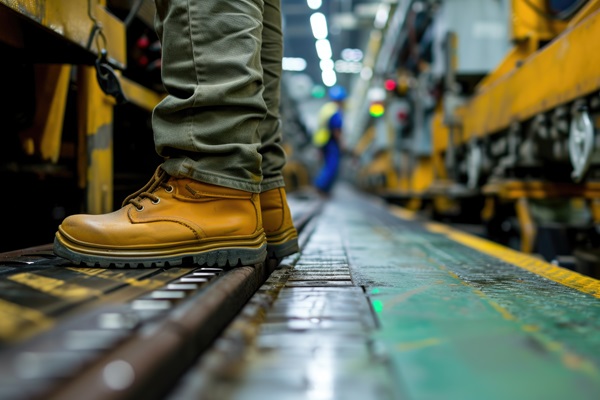The Slow Adoption of Workplace Safety Technology
Technology promises to revolutionize workplace safety by using robots, machines, and advanced information processing to reduce worker hazards and improve monitoring and alerts. However, businesses are slow to adopt these technologies, potentially putting workers at risk of injury where prevention could be implemented.
New survey explains barriers to on-the-job safety tech use
A recent survey by the National Safety Council (NSC) reveals that the adoption of workplace safety technology, especially personal protective equipment (PPE), has been slow. Employers are hesitant to switch due to a lack of perceived necessity. While employees are generally open to new technologies, nearly half are reluctant due to concerns about the learning curve and doubts about the benefits. About 45 percent of employees are proficient with their current PPE and worry that new technologies might compromise their safety. Consequently, some employers view the demand for upgrading safety tech as low.
No one should fear serious injury at work, yet severe accidents occur daily in Pennsylvania. Employers must ensure a safe workplace, and workers' compensation covers medical expenses and partial lost wages for injured employees. Vellner Law, PC offers legal help, but prevention is key. Here's what you need to know about available workplace safety technology and the barriers to its use.
Workplace safety technology
A new NSC study analyzes the use and effectiveness of various workplace safety technology. Here are some of the types of safety tech surveyed:
- Autonomous Mobile Robots (AMRs) for material handling. Autonomous mobile robots (AMRs) are sensor-enabled machines that navigate environments independently, without direct operator oversight or a fixed path. They reduce ergonomic risks, minimize material handling injuries, and boost productivity in material handling tasks.
- Fatigue monitoring. Wearable vital sign monitors track bodily metrics in real-time to measure worker fatigue, improving fatigue management and reducing absenteeism, presenteeism, and healthcare costs. Additionally, in-vehicle camera-based driver monitoring systems detect fatigued and distracted driving, alerting drivers and supervisors to real-time risks.
- Lone worker mobile applications. Mobile device applications designed to reduce workplace violence are particularly beneficial for employees working alone without direct supervision. These apps enhance lone worker monitoring, improve emergency response times, manage critical events, and facilitate better communication.
- Permit to work software. Digital workflow and content systems enable operations and safety managers to implement approval processes that manage risks associated with hazardous work activities and expedite job sign-offs. They also enhance on-site risk management through credential verification, improve hazard mitigation, and increase operational visibility.
- Proximity monitoring. Fixed and wearable sensors detect nearby objects without physical contact, alerting employees to impending collisions and hazardous situations. These proximity wearables help reduce transportation or contact-related incidents between employees and machinery or equipment.
- Virtual Reality (VR). Digital VR training devices immerse users in a fully computer-generated environment, allowing them to navigate as if physically present. This technology enables workers to gain realistic and immersive safety training experience in a simulated setting.
- Unmanned Aerial Vehicles (UAVs). Also known as drones, unmanned aerial vehicles are controlled from the ground and are used for confined space inspections. This technology reduces the need for humans to work in dangerous confined spaces and can enhance work quality and accuracy.
What's stopping businesses from adopting workplace safety tech?
Employees face work hazards head-on, so it's important to understand why a work site might not be adopting the safety tech that could protect them. Here's a look at the reasons for this lag in embracing potentially life-saving technologies, according to the NSC survey:
- Knowledge and alignment barriers. In addition to a shortage of resources for assessing an organization's readiness to implement new technologies, employers may struggle to see how safety tech aligns with their needs and values.
- Cost and approval challenges. The high initial purchase costs of safety technologies can be a deterrent, and there is often a lack of clarity regarding the return on investment.
- Privacy concerns. Employers are worried about the collection of personal information that may lead to illegal violations of employee privacy.
- Perceived adequacy and priority issues. There is a common perception that existing safety equipment is sufficient, and new safety technologies are not considered a high priority within many organizational strategies.
- Effectiveness and testing doubts. Employers have reservations about the effectiveness of safety technologies due to a perceived lack of testing or proof of their success in actual workplace environments.
After a workplace injury, Vellner Law is here for you
When workers are informed about available safety technology and the barriers to its adoption, they are empowered to advocate for better working conditions. This knowledge equips them to push for innovations that enhance workplace safety and well-being. However, if you've been injured on the job, Vellner Law, PC is here to help. With 30 years of experience, our Pennsylvania workers' compensation law firm will fight for the maximum compensation you deserve. Our work injury case results include:
- Over $1 million in settlement and Medicare set aside for a catastrophic work injury from a fall at a job site.
- Over $700,000 in settlement and medicals for a catastrophic construction site injury.
Contact us now for a free case evaluation. We serve injured workers in Allentown, Bethlehem, and throughout the Lehigh Valley.

